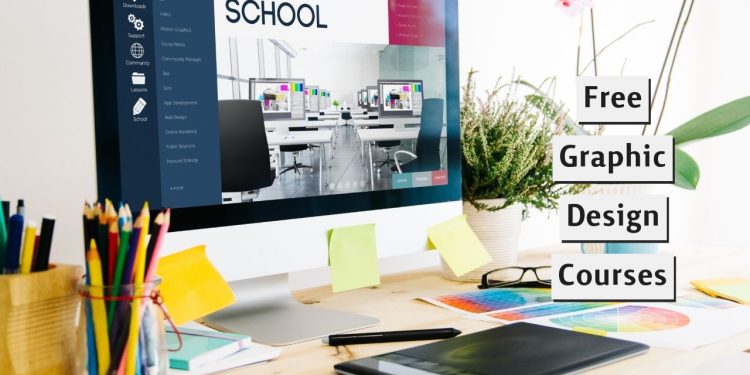There are numerous online graphic design courses available from colleges, graphic design specialists, and online course providers that can help you refine your design skills.
Whether you choose to study graphic design, a different language, and how to begin writing, there is already likely a tool that can guide you.
Are you interested in learning how to become a graphic designer through online learning? There is no one-way strategy to excellence.
It depends on your expertise, a number of graphic design online courses will enable you to develop graphic design skills and put you on the pathway to a rewarding and sustainable future.
We’ve prepared a list of the top best graphic design courses (Some free & some paid courses) with graphic design certificates available online in this article.
How to Become a Graphic Designer

Simply put, graphic design is a digital discipline that focuses on doing and creating designs using the software.
This is less college course and more practical.
There really are, however, a number of different ways to learn graphic design.
You should be fine with self-taught graphic design training if you are a self-starter, are familiar with online learning, have reasonably intelligent computer skills, and want to experience the graphic design field as well before narrowing your specialization.
If you’re new to online learning, want stage process direction and support, or have specific career goals that demand a higher degree of skill, you may need to look for a more organized, teacher course.
Best Graphic Design Courses Online
1. Adobe Illustrator For Beginners
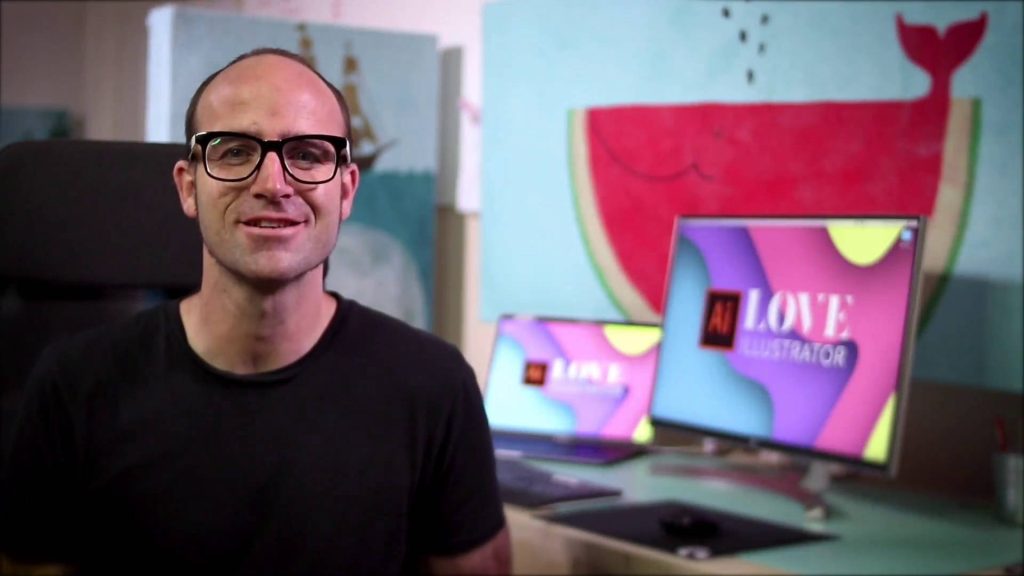
If you’re studying graphic design, you should be aware that Adobe offers industry-standard graphic design tools for creatives, as well as free trials and attractive student discounts of up to 65%.
Adobe’s ‘Creative Cloud’ membership service allows you access to a number of powerful design products, including Adobe Photoshop, Illustrator, InDesign, and others.
Many designers prefer Adobe Illustrator, and in this three-hour envato tuts+ Adobe Illustrator crash course, instructor Dan Scott covers everything you need to know about the application so you can start bringing your ideas to life.
Learn the fundamentals of building custom shapes, lines, and brushes, as well as how to use and edit text and work through the process of generating unique shapes, lines, and brushes. You can try it out on your PC, MacBook, and with a mobile phone.
2. Graphic Design Basics: Core Principles For Visual Design – Skillshare
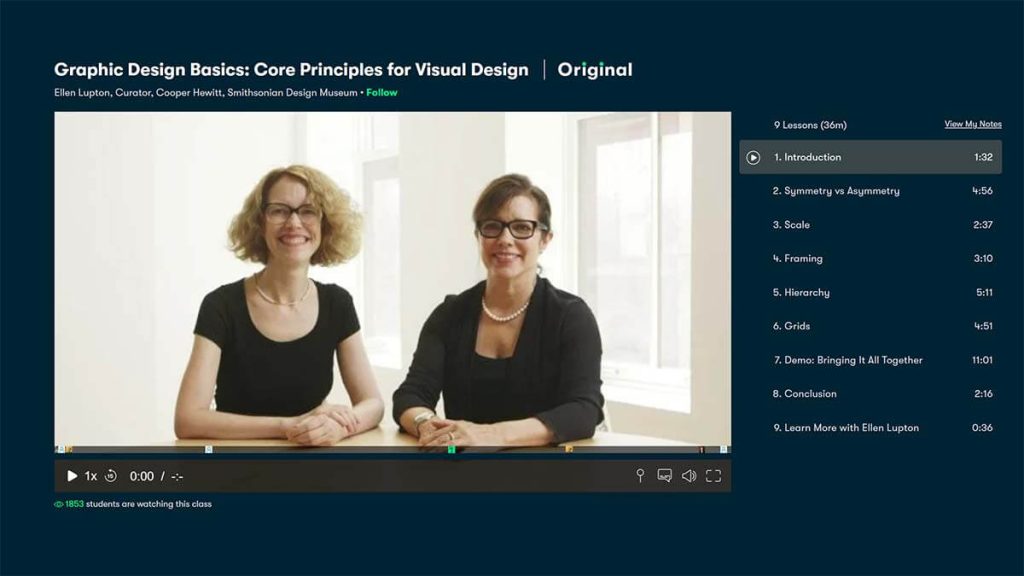
Whether you’re new to graphic design or an experienced pro, you have to start sometime. This entails beginning with the foundations which is what Graphic Design Basics: Core Principles for Visual Design is all about.
This 36-minute session will teach you 5 essential graphic design principles.
Another class led by Ellen Lupton and Jennifer Cole Phillips. This course will show you how to apply those core concepts to a variety of activities, including design concept, branding, and photo editing.
The following are some of the skills you’ll learn during the course::
- How to recognize and define the 5 main design principles
- How to look for balance and effectiveness in your work when critiquing it
- How can you use each topic in your future project?
In addition, SkillShare offers a 35-minute free session that explains the 5 basic concepts of graphic design.
Know how to develop concepts and ideas for any visual layout, including a book, magazine layout, website, or poster.
Since each class is taught by directors of the Maryland Institute College of Art’s Graphic Design MFA program, you’ll see lots of examples of graphic design work done by MICA students.
Prepare for a useful crash course in key design concepts such as symmetry, scale, framing, hierarchy, and grids, and then put your new knowledge to use.
3. Creating Brand System Course

The Creating Brand Systems course, taught by True Hand designers Mike Ski @mikeskiths and Jesse Jay @jessiejayths urges students to analyze how a great logo or brand system is created.
In six video courses, Ski and Jay explain the cooperative effort they used to create the logo for Kensington Quarters, a Philadelphia eatery.
Design teams, artists, hobbyists, and creatives will benefit from the Creating Brand Systems course. It’s a much more concentrated class than the others.
This course is for those who want a high-quality walkthrough of what it takes to build a dynamic logo that can be utilized in a variety of channels and applications.
4. Graphic Design Course By Coursera
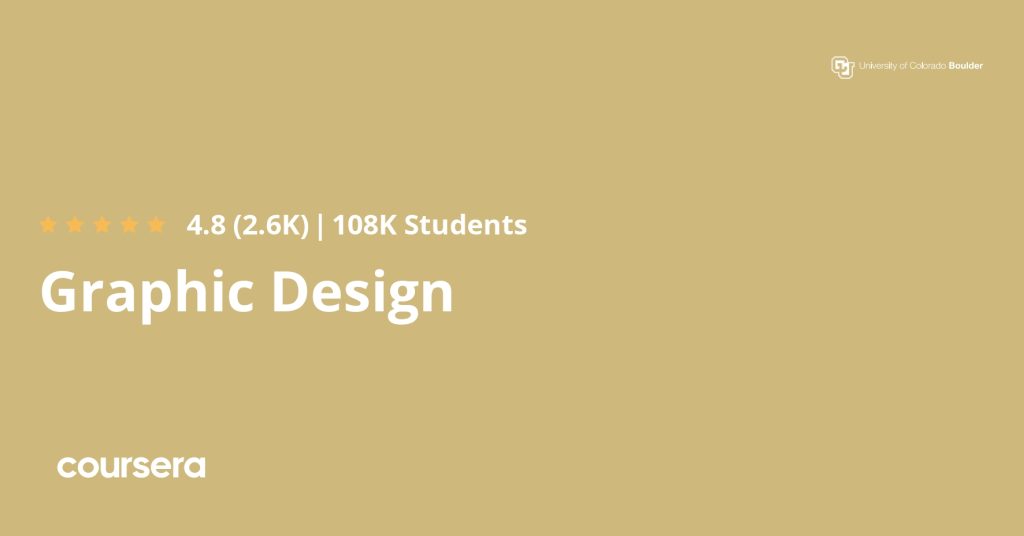
This Graphic Design course, taught by David Underwood, teaches all the skills you need to design professional-looking reports, resumes, presentations, and PowerPoints using methods, styles, and practices that have been developed through experience.
This course is broken into four parts:
Module 1: How to make your work look inspired and fresh.
Module 2: Go over the intensity of using a grid, detecting negative space, and using appropriate margins. The element palette, font, colors, images, and graphic components like borders, bars, and backdrops will all be examined.
Module 3: You’ll discover how a basic design “trick” can help your project stand out.
Module 4: Lastly, learn how to deal with criticism and apply what you’ve learned to make your project better.
5. Fundamentals Of Graphic Design – Coursera
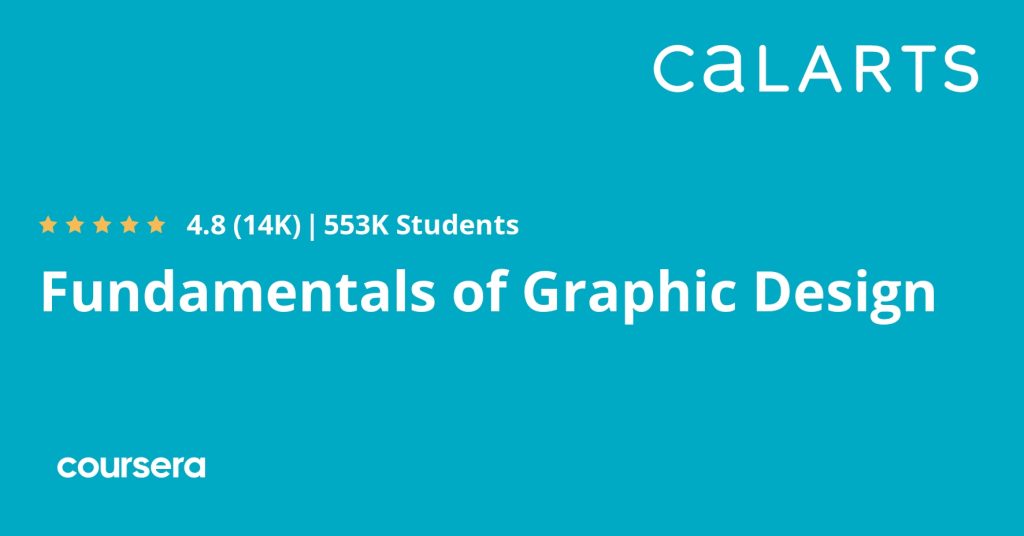
The course, led by Michael Worthington, will teach you how and where to use images, rhythm, and structures in your design from a professor of the California Institute of Arts faculty.
You’ll also learn how to use scale, direction, texture, weight, and space in your project, as well as image-making strategies and how to build your type of photos.
This is accomplished in the Fundamentals of Graphic Design course by dividing down the topics into four one-week pieces, each covering a separate topic:
Week 1 – Image-Making Fundamentals – In the first session, the instructor demonstrates how an image can transmit both connotative and denotative signals.
Week 2 – Typography Fundamentals – This week’s session will focus on typography fundamentals.
Week 3 – Shape and Color Fundamentals – Colors and patterns serve as the cornerstone for graphic designers’ work. In this week’s online session, you’ll get a deeper look at how they do it.
Week 4 – Composition Fundamentals – This week’s lesson will focus on how graphic designers use visual differences, scaling, direction, and organization in complex compositions and single images.
6. Introduction To Typography – Coursera

Anther Kiley, a graphic designer based in Los Angeles, educates anyone with a basic understanding of Adobe InDesign and access to it on how to get the most out of the program’s features and functions.
The Introduction to Typography course is divided into four weekly lesson plans that cover various aspects of typography:
Week 1 – Communicative type – The course examines typefaces as both physical items and works of design in this week’s session.
Week 2 – Typefaces and their Backgrounds – This week’s lesson focuses on how a typeface can represent connotative meaning, often known as how it can tell stories.
Week 3 – Putting Type to Work – The focus of this week’s session is on learning to apply visual concepts and typesetting rules. There’s also a look at how the gaps between letters, lines, and blocks of text can be tweaked to improve their appearance.
Week 4 – Making Meaningful Type – In the final week of the course, the class will look at how typography may have a significant impact on the meaning of the formal text.
7. The Introduction To Graphic Design- Udemy
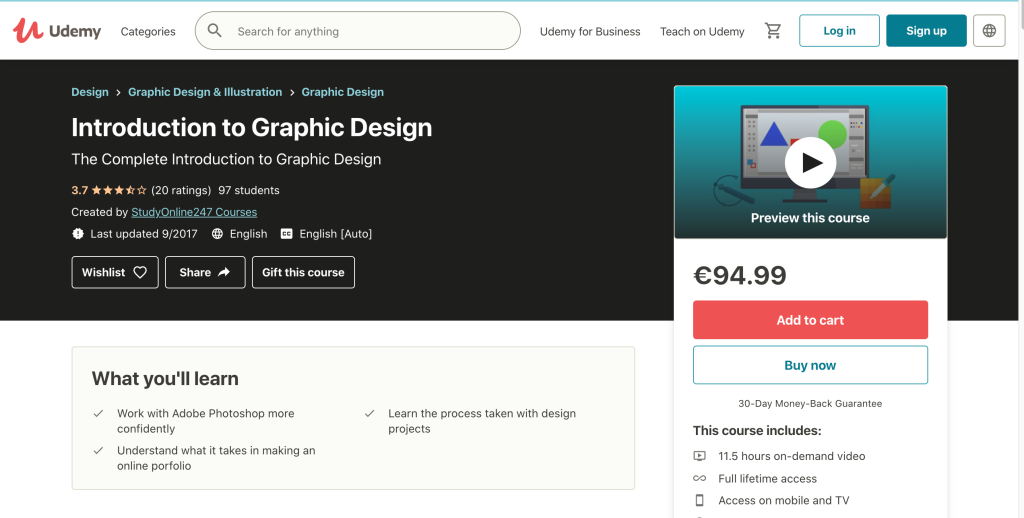
Udemy is an online course that was established in 2009 to help people learn the skills. Most of those classes on Udemy are appropriate for anyone who wants to study graphic design.
We chose a handful of them to highlight because we think you’ll find them useful.
This introductory program on Introduction to Graphic Design is an excellent place to get started with graphic design online courses.
It also serves as a springboard into the realm of graphic design by providing real-world examples.
There are no software-based requirements for this course.
As stated in the overview, the only prerequisite is an independent thinker and a willingness to learn.
To develop designs, you’ll utilize Canva, a web-based design tool.
The Introduction to Graphic Design course is a hands-on training course that teaches beginners about the graphic design industry, what constitutes a design, and how to design.
If you’ve ever been interested in graphic design but aren’t sure if it’s right for you, then this is a good step.
Both beginners and professionals will benefit from this course with 27 lectures and more than an hour of free course material made available.
You’ll learn everything there is to know about Canva as well as a variety of graphic design abilities that will come in handy in real-world projects like logo design and business card creation.
8. Rawson Uddin’s Adobe Illustrator Course – Udemy

Rawson Uddin’s Adobe Illustrator course will equip you with lifelong access to over seven hours of on-demand video sessions as well as a certificate of successful completion.
Since this is an advanced lesson, the only prerequisite is that you have a basic understanding of Adobe Illustrator.
Throughout the course, you will learn about a variety of topics that will assist you in designing your logo or maybe starting a side company designing logos. These are some of the topics:
What factors should you consider before selecting a typeface?
- In a design, using simple shapes
- Using negative space in your design
- Selecting colors for your logo to include more features in your graphic design
- You can download a working fidget spinner as part of the training.
9. Visual And Graphic Design – Alison

Complete the Visual and Graphic Design (2 modules, 1.5 to 3 hours) course on Alison Online and you will receive a graphic design certificate, which is ideal for anyone who is already studying graphic design.
Alison is one of the few online graphic design platforms that offer online graphic design courses with certificates.
A certification in a subject, on the other hand, might assist in creating credibility when looking for a new job or freelancing assignment if you are just starting as a graphic designer.
Alison Online, founded by Mike Feerick, provides fully free classes that are not credited.
This means that your present or potential employers may not recognize your completion certificate or diploma.
Alison Online, which promotes itself as an innovative system of free accredited learning, offers lessons in so many different disciplines that it’s worth trying out regardless.
There are various specialist seminars available to assist you to learn how to use the various software essential for graphic design, such as this one on Photoshop Essential Tools.
All of Alison’s courses are being taught using slide presentations. As a result, rather than scrolling through a big page of information, everything is broken down into manageable portions.
While it isn’t perfect, Alison is a fantastic free resource for anyone interested in learning graphic design
10. PIKTOCHART

While this course focuses mostly on visual storytelling, Piktochart is an excellent graphic design online tool for creating attractive infographics, reports, presentation slides, posters, and flyers, among other things.
This simple and comprehensive training by Sarah Kim will assist you in creating attractive images to make your communication more efficient or reaching out to the public to increase brand awareness.
There are seven lessons in this free course. An experienced teacher will explain how to design and execute a visually pleasing PowerPoint using Piktochart.
The following are some of the things you’ll learn during the course:
- How to construct a typography poster and design the content structure
- In Piktochart, how do you make a color scheme?
- How to Select and Use the Appropriate Icons
- How to use Piktochart to visualize data
- How to choose photos and change the orientation of the layout.
11. Canva’s Graphic Design Basics Course

Canva has expanded to include a design school where folks with little or no expertise with graphic design may learn the fundamentals and get helpful advice.
The Design School section of their website offers students a variety of tools that can help beginners, people with some expertise, or anyone who has worked in graphic design for a long period.
Anyone interested in learning the fundamentals of design should have a look at this course.
Canva’s Design School is divided into distinct sections for simple learning.
In this concise, packed course from Canva, you’ll get a solid foundation in graphic design. Canva’s Graphic Design Basics course is made up of twelve bite-sized lessons, each of which covers a foundational principle of graphic design and includes an activity that allows you to put your new skills to use.
From establishing your intended message to creating mood boards, color wheel and typography basics, and more, you’ll receive a taste of vital design know-how.
12. California Institute Of Arts

The California Institute of the Arts offers a free graphic design specialization session through Coursera and it’s one of the best online graphic design courses.
These five beginner-level classes are each presented by a CalArts faculty member and are jam-packed with industry knowledge.
With this graphic design focus, you’ll learn the fundamental skills needed to begin a career as a professional designer, how to develop communication skills, and how graphic design ties to other disciplines like interaction design, visual effects, and editorial design.
Here’s a brief breakdown of each course:
- Course 1: Foundations of Graphic Design
- Course 2: Introduction to Typography
- Course 3: Introductory to image-making
- Course 4: Graphic design concepts from the ancient times.
- Course 5: Brand new brand.
13. Massachusetts Institute Of Technology

The OpenCourseWare of the Massachusetts Institute of Technology is available on the internet. OpenCourseWare is the most open kind of learning.
It’s an online database of free online courses developed by qualified academic lecturers and course designers.
The bulk of these design courses’ online programs is part of a wider lesson, such as website programming. They are, notwithstanding, still useful and valuable tools.
Additionally, rather than concentrating exclusively on design theory, these courses provide a high priority on actual application.
The site is well-organized, making it simple to navigate and locate the classes you need plus the skills to assist you in learning graphic design concepts and techniques.
You will never be linked to commercials or attempting to sell sales pitches for premium services because MIT’s OpenCourseWare is a non-profit initiative.
The graphic design class is a component of a user interface design course. It includes a few simple activities to assist you in learning graphic design concepts and techniques.
This includes looking at a few different websites to see how they handle graphic design and how they may improve.
A variety of other resources, such as lectures on design, are also available.
Conclusion
With the rise of the internet, you may now become a graphic designer at your leisure and at almost no expense.
Make use of these helpful online graphic design classes, resources, and tutorials to get started on your learning path.
Mastering design, like any other field, will require dedication and effort.
However, if you’re serious about working in this interesting sector, know that it’s both possible and affordable.
If the free design online classes do not convince you, you can enroll in the premium classes, which come with their own set of benefits and shared expertise.
It is advised to opt for online graphic design courses with certificates.
Some of these platforms offer free courses and credentials in one package. You may easily check out any of the platforms above if you want to improve your graphic design skills and obtain more expertise on graphic design, or if you just want to learn for your personal use.
FAQs
What software do graphic designers use?
Premiere Pro, Adobe Creative Suite, Autocad, CorelDRAW, and a plethora of additional Adobe Creative Cloud applications are all accessible.
You may learn more about the software that graphic artists use by visiting this page. A graphic designer has practically unrestricted access to applications.
How can I get started as a graphic designer?
As a graphic designer seeking exposure, get a graphic design certificate and also create an online portfolio to show off your projects. Build work experience, establish your brand and vision to take on larger projects along with a dedicated workforce, or work as a solo.

